Tag: Joseph Kulesza ’22
Tangents & Tirades
by kwheele4 on February 4, 2021
Opinion
Masks Should Not Embolden Risk-Taking
by Joseph Kulesza ’22
Despite all of the controversy surrounding masks, the vast majority of people do not have an issue with wearing them. According to a KFF Health Tracking poll, 87% of Democrats, 71% of independents, and 55% of Republicans report that they wear masks every time they leave their home.
It only seems like common sense that wearing face coverings would reduce the spread of an airborne illness: the fabric, polypropylene, or other synthetic fibers trap aerosol particles and larger droplets that leave our noses and mouths, preventing them from becoming suspended in the air.
If most people do not take issue with masks, and science proves they are an effective tool in stopping the spread of COVID-19, then why are masks not a silver bullet for ending the pandemic?
Part of the issue with masks is psychological. Though wearing a mask can protect you and others from transmitting the virus, it can also embolden riskier behavior. This increased willingness to take on risk is explained by a psychological term known as risk compensation.
This same principle of risk compensation was seen in the NFL, as a study concluded that newer helmets worn by players actually resulted in more injuries, given that players made riskier moves as a result of their false sense of security.
Yes, masks are designed to protect you and those around you. However, masks should not be viewed as indestructible armor that permits you to engage in risky behavior. People must still follow social distancing guidelines, refrain from unnecessary travel, and adhere to other safety protocols even if they are sporting a mask.
Masks and helmets aside, the greatest protection against injury or illness is common sense. With a new semester beginning, the Providence College community needs to use common sense to keep everyone safe.
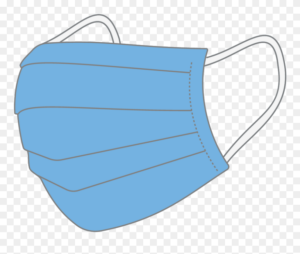
Jill Biden: Qualified and Inspiring FLOTUS
by Erin Garvey ’22
As America watches President Joseph Biden begin his presidential term, we also look in anticipation at Dr. Jill Biden. Dr. Biden displayed some of her valuable traits during her time as the second lady for eight years. She was able to learn and grow under former First Lady Michelle Obama, seeing what a true first lady must represent. The two possess many similarities, including the confidence to share their values.
Despite only being in office for a few weeks, Dr. Biden has already expressed her largest concerns and her plans for implementing new policies. She is a large supporter of education, as seen by her decision to become a teacher. With her love and passion for education, it was not surprising that Dr. Biden expressed an interest in improving the current education system in the United States.
In fact, not only has Dr. Biden promised to create change during her time in the White House, she has also expressed that she intends to continue working as a professor while serving as FLOTUS. This indicates her genuine passion for education and also means that she can serve as a strong role model for members of our nation. Dr. Biden’s career-driven attitude is inspiring, and this is something that our country can benefit from as we aim to battle against traditional gender roles.
Although the Biden family has only recently set up shop in the White House, the qualities that Dr. Biden has already demonstrated during her short time as FLOTUS are extremely encouraging.
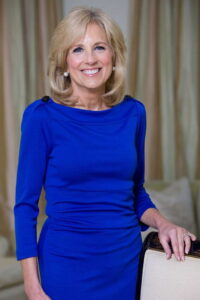
Just How Catholic are Catholic Schools?: Taking Pride in the Strength of PC is Catholic Identity
by The Cowl Editor on October 29, 2020
Campus

Just How Catholic are Catholic Schools?: Taking Pride in the Strength of PC is Catholic Identity
By Joseph Kulesza ’22
Opinion Staff
If it is in the name, does it have to be true? A three-ring binder has three rings; a ferris wheel is indeed in the shape of a wheel; and a water bottle can and usually does hold water. But are Catholic schools actually Catholic?
Critics of Catholic schools have spoken out against the authenticity of these institutions, suggesting that “Catholic” schools are only Catholic in name.
An article published by The Atlantic in 2015 accused Catholic schools of not practicing what they preach, stating that “six of the top 20 nonprofit colleges that are most expensive for low-income students are Catholic institutions.” This Atlantic writer argued that Catholic schools exercise a preferential option for their endowments rather than a preferential option for the poor.
Catholic schools have been further criticized for both giving into and adopting certain curricular fads similar to those of their secular counterparts. While many of these decisions have been optional, the more well-known instances of these curricular changes have been the adoption of state-mandated common core curriculums in several Catholic high schools.
While there is plenty of criticism directed towards Catholic schools as a whole, readers of this article are likely wondering where Providence College falls into this mix.
At first glance, Providence College appears to be a Catholic school in many respects. There are crucifixes on the walls in each classroom, Gothic buildings that are a hallmark of the Church, and Dominicans walking around campus in white habits.
But, appearance does not always infer essence, and, as in all things, there can be difference between what is and what appears to be. The question now becomes whether or not this adage applies to PC. The answer to this question is best found in the people on campus, rather than the campus itself.
Inside the Ruane Center for the Humanities, Dominicans and professors alike can be seen passionately teaching one of the several staple Development of Western Civilization courses. These courses, as well as the professors who teach them, make Providence College the college it is—so much so that those three letters, D-W-C, will remain meaningful to students for the rest of their lives, and will likely give them flashbacks to reading the Aeneid.
Over the lockdown, friars rode around on golf carts playing guitars, making it on virtually every Eaton Street resident’s Snapchat story and brought them hope in an otherwise not so hopeful period.
And finally, whether students realize it or not, a large network of faculty, staff, and friars work every day for the further development of students, so that they can leave this campus with more than just a good job offer.
The members of the campus community contribute to the institution more than any other factor ever will, and in this way, the people of PC living out the Catholic mission make the College deserving of its Catholic title.
With this said, in many cases the criticisms directed at Catholic schools are fair. The higher education marketplace has become a cut-throat industry, where many colleges (not just Catholic ones) are willing to barter their integrity to increase their endowment, selectivity, or prestige.
Anthony Carnevale, a professor at Georgetown University who commented in the previously mentioned Atlantic article entitled “The Irony of Catholic Colleges,” summarized the situation well: “Christianity, let alone Catholicism, is supposed to be about taking care of each other and throwing the money changers out of the temple, but Jesus didn’t have to run a college.”
Deciding between integrity and competition is something that Catholic schools have to consider now more than ever before. The hope is that these schools side with integrity, as it can be argued that a corrupt school is worse than a bankrupt one.
Thankfully, PC’s commitment to its Catholic identity can be seen throughout and experienced on campus. As such, students can be proud to attend a college that remains true to its Catholic title.
You Are What You Look at: We Spend Too Much Time Looking at Other People
by The Cowl Editor on October 1, 2020
Opinion
You Are What You Look at: We Spend Too Much Time Looking at Other People
by Joseph Kulesza ’22
Opinion Staff
We spend a lot of time looking at other people. The average person will spend a total of 3,462,390 minutes on social media during their lifetime. Assuming that this time is not spent exclusively looking at one’s own page, social media has allowed people to follow others’ lives at a closer, virtual proximity. With over five years of our life dedicated to this one endeavor, it is in one’s best interest to understand how and why this time is being spent.
We often look at other people because they have something we do not. Cristiano Ronaldo has 237 million followers on Instagram because he has innate athletic talent and a lifestyle that 237 million people find desirable in contrast to their own lives. Ariana Grande has 202 million followers because she has something, namely fame and notoriety, that 202 million people also find appealing. Similar attributes can be said for Dwayne Johnson, Kylie Jenner, and Selena Gomez, who respectively have the third, fourth, and fifth most followed accounts on Instagram.
At face value, admiring, or even idolizing these people appears to be an innocent or benign habit. But this tendency has concrete repercussions that may never be recognized by social media users.
The first problem arises from the very reason public figures are public to begin with: they have something other people do not. Some of us may recall from our Development of Western Civilization classes that envy is one of the seven deadly sins.
In being fixated on another’s goods, comparisons are made between oneself and others. In this way, everything can become a competition between what others have and what one wants. This competition is not only one that is impossible to win, but is also an unfair one, as on social media, people make their lives look much better than they actually are. Viewers are always at a disadvantage.
When people excel in one area, we tend to expect that they excel in all other areas as well, something known as the halo effect. Athletes that excel in utilizing their physical talents or artists who excel in writing music may lack skills in other areas of their lives. It does not take long to think of examples supporting this claim.
Ultimately we should spend less time looking at other people and more time looking at ourselves. Introspection is not a selfish trait, but rather a tool that allows people to better themselves so that they may better others. 3,462,390 minutes is a lot of time that, spent fruitfully, could positively impact the other millions of minutes that constitute our lives.
Tangents & Tirades
by The Cowl Editor on September 17, 2020
Opinion
Preparing for the “Real World”
“College will prepare you for the real world.” This is what teenagers hear from the time they enter high school to when they walk across the stage at commencement as adults. Why, then, is it that so many college students enter the real world with no idea how to adequately exist in it? Sitting behind a desk in an office is not the real world, even if you can see the real world from your skyline view.
College students would be remiss thinking that a career is the real world. If you have a free elective or need to fulfill a core curriculum requirement, take a course on contemporary social issues, like Dr. Kara Cebulko’s immigration course. Or learn about historically marginalized communities with a course like Race and Politics in the Americas or Race and Racism. Maybe study abroad for a semester to learn about African, Asian, or Latin American cultures.
Do not do it simply to satisfy a core curriculum requirement. Do it so that you are prepared for the real world. Do it so that you know how to respect your coworkers of different ethnicities. Do it because your future child’s best friend could be undocumented. Do it so that your five-dollar bills go into an empty hat on the sidewalk instead of an empty glass at the bar. This is the real world: you could be the richest attorney, accountant, or engineer in America and still not know how to make a fat cat well-rounded.
—Nicole Patano ‘22
The Novelty of Masks
Looking around one’s house, you are likely to come across items that were once exciting or important to you, but no longer are.
All of that Reebok CrossFit apparel you bought when it was popular in 2014 collects dust in the basement next to the treadmill you seldom use. Stuffed in the back of your kitchen cabinet is that once-trendy soda machine thing you bought from Bed, Bath and Beyond.
It is becoming apparent that another item, while not a discretionary one, is facing a similar fate and going out of style.
Masks on campus are visibly being worn less and less, as the novelty of wearing them is quickly waning. Students who were presumably nervous about disciplinary consequences for not wearing masks were surprised to see that you can get away with neglecting to wear one.
However, the important question is not whether you can get away with not wearing masks, but why you should wear them.
Providence College has invested large amounts of time, energy, and resources in order to prevent outbreaks on campus.
Thousands of disinfecting wipes, reconfigured class release times to stagger the departure of students from buildings, and even a website dedicated to informing students about COVID-19-related updates has been created.
All of these efforts are monumental in respect to the simple act of wearing a mask, yet these efforts are all for naught if masks are not worn.
Wearing a mask is the most effective means that students can contribute to continuing this semester on-campus.
—Joseph Kulesza ’22
Treat the Pandemic with Sensitivity
The loss of a loved one is no joking matter. In this time of unrest for so many, Providence College students, faculty, and administration need to recognize the immense burden the COVID-19 pandemic has placed on everyone’s personal lives. We must strive to foster a community of compassion, self-awareness, and consideration.
Hundreds of thousands offamilies have lost loved ones to COVID-19; it is sad, but true. Recently, however, many people have made COVID-19 the subject of memes. There seems to be a palpable disconnect between these memes and the fact that death is serious and the virus that runs so violently around us can take hold of anyone at any second.
Although you may not have been personally impacted by the pandemic, it is insensitive to assume that your experience is universal. It is a privilege to be able to say that COVID-19 has not significantly impacted your life beyond having to follow new guidelines and take classes over Zoom.
Simply put, everyone on PC’s campus needs to take a step back, realize their place in the grand scheme of our world, and recognize that words and actions can affect others so much more powerfully than they assume.
—Olivia Bretzman ’22
Goya, Face Masks, and In-Person Schooling: Political Discord Leads to Total Division in the United States
by Andrea Traietti on September 3, 2020
Opinion
by Joseph Kulesza ’22
Opinion Staff
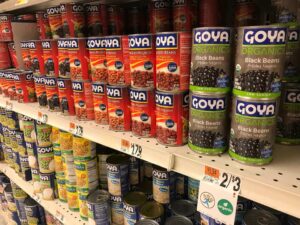
If you asked someone in 2010, “What is the commonality between face masks, going to school, and Goya canned beans,” your question would likely be met with a confused stare rather than a verbal response. Before the age of COVID-19 and today’s climate of mounting political divisiveness, disagreements over such frivolous topics seemed more likely to get on Comedy Central rather than CNN or the Wall Street Journal.
However, for all of us living in the present time, the insanity that comes along with a polarized political system seems all too normal, so much so that what seemed insane only a decade ago is the new normal of the present day. In order to successfully tackle the problems America faces today, we as a society need to focus more on our shared humanity and end our culture of “otherness.”
Today, America is experiencing levels of political discord that are unlike anything the country has faced in its 244-year history. “Liberal” and “conservative” have become such charged words that they are almost considered insults rather than descriptive words meant to characterize sets of ideological beliefs.
The once applicable bell curve of political party distribution has been flattened, with moderates and independents fleeing to either opposing end, petrified to be caught anywhere near the median.
This trend is not a topic of pure speculation but has been tracked by Pew Research. Over the past 20 years, “The number of Americans in the ‘tails’ of this ideological distribution has doubled from 10% to 21%.”
This shift represents “both Democrats moving to the left and Republicans moving to the right,” with fewer and fewer commonalities shared between the parties and, by extension, the people who constitute them.
The weakening center is only getting worse, as today, “92% of Republicans are to the right of the median Democrat, compared with 64% 20 years ago.” The same can be said of the opposing side, as “94% of Democrats are to the left of the median Republican, up from 70% in 1994.”
While political contention is what fills the majority of news stories, division in America is no longer a liberal versus conservative problem. The polarization of politics has boiled over to pollute other aspects of life. A Republican versus Democrat problem is now a rich versus poor problem, a male versus female problem, and a climate change believer versus climate change denier problem. Discord has successfully and completely saturated every aspect of our lives.
With this conflict comes the establishment of concrete sides, which people adopt as their identities. When we see others as a liberal, a climate change denier, or mask-wearer, we forget to regard others as human. College students, coworkers, and neighbors must place their faith in our shared humanity, as it is this component of our being that is the most robust and most meaningful. When we see others as a school-goer, a mask-wearer, or more recently a Goya-canned-black-beans-eater, we forget that undergirding all of these identities is a much more profound one—the identity of our shared humanity.
As long as we see people as being an “other,” we will treat them as such. It is in everyone’s best interest to regard one another as being distinctly human first, and everything else second.
Maybe then the day will come where we can all sit around and eat some canned beans together, on a school campus, not having to wear facemasks.
2020 has been a tough year, and society’s tendency to erect barriers does not make it any easier. Seeing people as human beings and not “others” is a fundamental first step to ensuring that we can proudly reflect upon this time in history in the years to come.
Tangents & Tirades
by Andrea Traietti on January 30, 2020
Tangents
The Shower Charade
For nearly everyone, the shower serves as a type of modern shrine. While monks meditate in the mountains, we students seek a similar Zen state of mind in our very own showers.
This comes as no surprise, though, because the shower is one of the only places where we can stare at a wall for 45 minutes and enjoy every second of it.
It is a shame that the place we hold so dear is under attack here at Providence College. The assailant takes on a nameless, faceless, and intangible description, and only submits to the laws of fluid dynamics. It is what allows us to brush our teeth and wash our hands, only to hurt us when we least expect it. It is the water pressure.
What was once a safe refuge in the bathroom has now been turned into a dangerous place where we all stand vulnerable to extreme water temperatures at any moment. With only the flush of a toilet, or a turn of the faucet handle, our peace of mind is scorched away in an acute stream of blistering water.
The shower charade is unfortunately known by many underclassmen who live in the dorms, and is in many ways an unavoidable aspect of college life. Red skin and boiling water aside, this unusual quirk of PC is only a fraction of the college experience, and in a very real way will make this experience that much more memorable.
—Joseph Kulesza ’22

Ray Improves Everything but Hours
Raymond Dining Hall has made many changes this semester, some of which include adding a full omelet bar, more stove tops at the U-Cook station, fruit smoothies in the mornings, and many more new features.
Although the quality of the food is improving, the one thing that they did not fix and should focus on improving is the inconvenient hours.
They advertise that breakfast is served daily until 11 a.m. from Monday to Friday, yet when students get out of their 9:30 a.m. class at 10:20 a.m. and rush to Ray for breakfast, most of the breakfast foods are being put away. They are left to pick between toast, bagels, and the lunch foods that are already being put out. If breakfast is open until 11 a.m., the breakfast foods should stay out until then.
Some may argue that students should wake up earlier and get breakfast before class, but this option may not be possible for students who stay up late studying.
Another aspect of the operating hours that Ray should amend is the closing times. From Monday to Thursday Ray is open until 9 p.m., on Friday and Saturday until 7 p.m., and on Sunday until 8 p.m. The variation in these hours is confusing, as students often mix up the timing and forget which day closes at which time.
Furthermore, Ray should stay open later than 7 p.m. on weekend nights, like other schools do, in order to offer late night meals and snacks. Although the dining hall offers “late night” breakfast or snacks during finals weeks, they should work to offer this feature more often.
All of the hard work put into improving the quality of the food at Raymond Dining Hall has produced satisfactory results. The next step in this improvement process must be the hours of operation as they are both inconvenient and confusing.
—Emily Ball ’22
Being a Respectful Netflix Viewer
Hernandez, Simpson, Bundy. While some of these names previously represented famous figures turned murderers, it seems that Netflix has changed their identities yet again—documentary series stars.
Netflix now has a number of major documentary series out about murder trials, all of which are extremely popular. Some of the major ones are The People vs. O.J. Simpson, Making a Murderer, and The Ted Bundy Tapes. Within the past month, two more series were added, including The Mind of Aaron Hernandez and Don’t F**k with Cats.
What all these series have in common is the entertainment value they produce. They tend to immerse their audience in the trial and give insight into the mind of the killers to better understand their motives. At the end of the day, these are series based off of someone else’s murder and should be treated as such.
While the intrigue inside the murderers’ minds can be all-consuming, it is important to remember what these shows are about, and that there is a respectful way to watch them and talk about them.
When you overhear people talking about the new binge-worthy series on Netflix, do not forget the show is about someone’s death, and respect should be paid to the victim. Rather than talking about these series as fictional shows, remember the victims and their families. For the families, these Netflix series serve as constant reminders of their loss, and we should all remember to be as respectful as possible when discussing these series.
—Katie Belbusti ’22
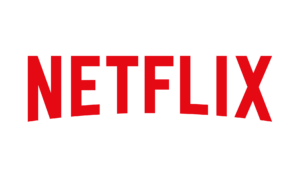
Combatting the Canada Goose Complex: The Winter Clothing Company Known for More Than Keeping People Warm
by The Cowl Editor on November 21, 2019
Opinion

by Joseph Kulesza ’22
Opinion Staff
As winter approaches, a mirage of coats, jackets, and sweaters will begin to appear on students around the Providence College campus. While many might be branded with the words “Patagonia” or “L.L. Bean”, the most controversial of these clothing articles has a large red circle embroidered on the sleeve, and has been featured in more than just commercials promoting the sale of this product.
With humble beginnings as a working class jacket, it is surprising to see just how far the Canada Goose jacket has come. From the backs of working class laborers in the oil fields of Northern Canada, to Kate Upton’s in a Sports Illustrated Swim Suit Edition that brought unprecedented recognition to this brand, Canada Goose is the antithesis of the saying that “success doesn’t happen overnight”.
From the years 2015 to 2018, the company experienced a 77% increase in revenues, and as its revenues increased, so did the likelihood of seeing this jacket being worn by figures other than super models and Canadian oil field workers.
Canada Goose’s overnight success has been accompanied by controversial news stories, smear campaigns from PETA, and instances of this jacket even being banned from certain school districts in the United Kingdom.
With all of this controversy surrounding the brand, the question arises as to whether any of it is justified, as a winter outerwear company usually is not the first idea that comes to mind when thinking of controversial matters. This is especially apparent in the context of a tumultuous year, including ongoing Middle Eastern civil wars, government impeachment hearings, and international trade tariffs.
The outrage associated with Canada Goose stems from multiple origins, but for the sake of brevity, this article will only focus on the controversy regarding the social implications of this jacket.
Most of Canada Goose’s success has come through the company’s ability to occupy a specific niche within the discretionary market.
Nestled in-between more common manufacturers such as Patagonia, and ultra high-end luxury brands such as Moncler, Canada Goose is just expensive enough to boast a degree of exclusivity, yet is not so expensive that it is affordable to only an elite portion of the population.
This positioning of Canada Goose results in a divide between the people who have Canada Goose and those who do not that is prevalent enough to be seen as an issue, and is claimed to exacerbate socioeconomic differences between students.
Although this philosophy is not commonly-followed in our materialistic society, consumers should buy discretionary goods like they buy stocks—purchase items for their intrinsic value rather than value that is perceived.
This notion seems rather arbitrary, but becomes pertinent after realizing that the market price of a product reflects both its actual worth and value that consumers think the product is worth.
In the same way that speculation drives up stock prices, the speculated value of products—existent mainly in the social capital a product possesses— artificially inflates a product’s demand, allowing producers to charge prices that are disproportional to the cost of comparable alternatives.
The only real difference between a $1,195 Canada Goose parka and a $400 Arc’ teryx one (which uses a higher quality down than Canada Goose), is a circular logo on the arm of the more expensive one. Contained in this logo is the social capital associated with the product, and along with this idea comes the price that is unattainable for many.
Purchasing products like we do stocks is a way to protect consumers from inflated prices, all the while giving us the peace of mind that there is one less-controversial topic for your relatives to get into an argument about at Thanksgiving dinner.
The Reusable Straw Revolution
by The Cowl Editor on October 31, 2019
Opinion
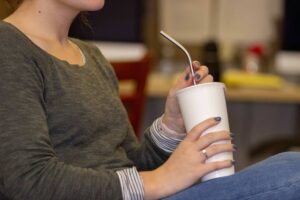
by Joseph Kulesza ’22
Opinion Staff
The reusable straw revolution, a product of the fourth wave environmentalism movement, officially reached its terminal velocity when the coffee company Starbucks announced a campaign to eliminate plastic straws on a national scale in July of 2018, according to the New York Times. This decision by Starbucks has had a drastic effect on consumers’ attitudes towards these single use products.
The subsequent paradigm shift in consumers’ relationships with plastic straws has manifested itself in public outcry, websites, and various hashtags which are all part of a new movement that claims to be the sole agent expediting the demise of plastic straws in the name of saving the environment.
This highly publicized movement is seen by many as a crucial step in humanity’s attempt to reduce our impact on the natural world. But, when reduced to its intrinsic worth, much of what this movement stands for and claims to be is nothing more than a distraction from a superseding issue that is not nearly as convenient, vogue, or hashtagable to address.
Looking at this movement at face value, the reusable straw revolution appears to cause no harm. In fact, virtually everyone considers it to have a net positive effect on the environment.
Even with plastic straws comprising less than one percent of the waste stream, according to the Stanford Woods Institute for the Environment, with the efforts of the numerous hashtags, websites, and the awareness generated by the reusable straw movement as a whole, there is potentially one percent less plastic entering the oceans and surrounding environments than before. Who can argue with that?
Although this sounds only beneficial, the real issue with this movement arises when taking into consideration the impact that it has not just on the environment, but on the participant.
When a participant in the reusable straw revolution makes the decision to abstain from using a plastic straw, they believe that they have won points on their moral balance sheet.
This self-conceived high moral balance all too often leads companies and customers to assume that they have done their part already and do not have to do anymore.
The psychological bargaining that happens with all humans in these situations is a phenomenon known as moral licensing, and it is especially prevelant in the context of this environmental fad.
Considering that the impact of using a reusable straw is minimal in light of the issue of pollution as a whole, it starts to look as if this whole movement does not seem like everything it is made out to be.
Furthermore, this ancillary environmental movement and its publicity might actually be cannibalizing the issue it is purporting to solve, in that it distracts the public from other underlying issues associated with pollution that are more pressing in nature.
If any real progress is to be made in addressing the environmental issue of pollution, the plastic straw revolution needs to be seen as simply a starting point for further action.
So yes, your reusable straw will not end up in the stomach of a sea turtle, but the plastic packaging it came in might.
Trendy movements can be good, but only insofar as they result in additional progress rather than distraction from the issue they are proposing to solve.
